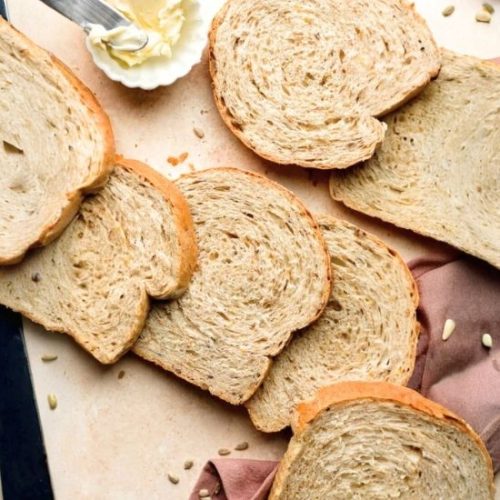
Multigrain Bread
A nourishing, soft multigrain bread with a fluffy interior and wholesome texture, enhanced by optional seeds or dried fruits. This recipe guides you through a straightforward process to create a delicious, fiber-rich loaf perfect for sandwiches or breakfast.
Equipment
- 1 Electric Stand Mixer with dough hook attachment
- 1 9×5-Inch Loaf Pan
- 1 Digital Instant Read Thermometer
- 1 Rolling Pin
- 1 Silicone Spatula
Ingredients
- ½ cup 60g dry multigrain cereal blend or rolled whole oats
- 1¾ cups 410ml boiling water
- 2¼ teaspoons 7g active dry or instant yeast (one standard packet)
- 3 tablespoons 37g packed brown sugar (light or dark)
- 3 tablespoons 43g unsalted butter, softened to room temperature
- 1½ teaspoons salt
- 3⅓ cups 433g bread flour, plus extra for dusting and adjustments
- Optional add-ins: ½ cup 60g sunflower seeds, chopped nuts, pepitas, raisins, or dried cranberries
Instructions
- Soak the Grains: Place your multigrain cereal or oats in a large heatproof mixing bowl. Pour the boiling water over the grains and stir gently. Let the mixture cool until it reaches about 110°F (43°C) — warm enough to activate yeast but not so hot that it kills it. This usually takes around 20 minutes.
- Activate Yeast Mixture: Add the yeast and brown sugar into the warm grain mixture. Using a stand mixer fitted with a dough hook or paddle attachment (or a large spoon if mixing by hand), stir gently to combine. Cover the bowl and let it rest for 5 to 10 minutes until the surface bubbles and becomes foamy, indicating the yeast is active.
- Incorporate Butter, Salt, and Flour: Add the softened butter, salt, and 1 cup (about 130g) of bread flour to the yeast mixture. Mix on low speed for about 30 seconds. Stop to scrape down the sides of the bowl, then add another cup of flour and continue mixing on medium until combined, though small lumps of butter may remain.
- Add Remaining Flour and Optional Ingredients: Add the remaining flour all at once, along with your choice of seeds or dried fruit if using. Mix on medium speed for about 2 minutes, or until the dough pulls away from the sides of the bowl and forms a cohesive ball. If the dough feels too sticky, add flour one tablespoon at a time until it firms up slightly but remains soft and tacky.
- Knead the Dough: Continue kneading the dough in the stand mixer for 3 to 5 more minutes, or alternatively, transfer it to a lightly floured surface and knead by hand for the same amount of time. The dough should be soft, elastic, and slightly tacky without sticking excessively. Perform a “windowpane test” by stretching a small piece of dough thinly—if light passes through without tearing, it’s ready.
- First Rise: Lightly oil a large clean bowl with olive oil or nonstick spray. Place the dough in the bowl and turn it to coat all sides in oil. Cover the bowl with plastic wrap, a towel, or foil and let it rise in a warm, draft-free spot for 1 to 2 hours, or until the dough has roughly doubled in size.
- Prepare Loaf Pan and Shape Dough: Grease a 9×5-inch loaf pan. Punch down the risen dough to release trapped air. On a lightly floured surface, roll the dough out into an approximately 8×15-inch rectangle. Don’t worry about perfect edges—rustic shapes are fine. Roll the dough tightly into an 8-inch log and place it seam side down into the prepared pan.
- Second Rise: Cover the loaf pan loosely with foil, plastic wrap, or a clean kitchen towel. Let the dough rise again until it’s about 1 to 2 inches above the pan’s rim, typically around 1 hour.
- Bake the Bread: Position your oven rack on a lower level and preheat the oven to 350°F (177°C). Bake the bread for 35 to 40 minutes. If the crust begins to brown too quickly, tent the loaf loosely with foil to prevent burning. The bread is done when it sounds hollow when tapped or an instant-read thermometer inserted in the center reads between 195°F and 200°F (90°C–93°C).
- Cool and Store: Remove the loaf from the oven and allow it to cool in the pan for several minutes. Transfer it to a cooling rack and let it cool completely before slicing for best texture. Store leftover bread tightly wrapped at room temperature for 2 to 3 days, or refrigerate up to 10 days.
Notes
- Grain Options: Any plain multigrain hot cereal mix works well, including 5-, 7-, or 10-grain blends. Avoid flavored or sweetened cereals to keep the bread balanced. Rolled oats are a great substitute if multigrain blends aren’t available.
- Yeast Choice: Both active dry and instant yeast can be used interchangeably; just ensure water temperature is correct to activate the yeast properly.
- Flour Substitutions: Bread flour is preferred for a sturdy, elastic crumb, but all-purpose flour can be substituted with slightly softer texture. Up to 1 cup whole wheat flour can be added for nuttiness, but expect a denser loaf.
- Add-ins: Seeds and dried fruits add flavor and texture. For smaller seeds like chia or flax, reduce the quantity to 2–3 tablespoons, or mix with larger seeds/nuts for best results.
- Freezing: Dough doesn’t freeze well after rising but the baked loaf freezes beautifully for up to 3 months. Thaw fully before slicing or reheating.
- Overnight Rise: For convenience, you can refrigerate the shaped loaf overnight and bake the next day after allowing it to come to room temperature and complete its final rise.